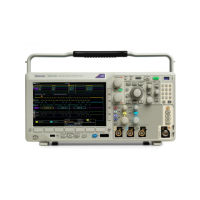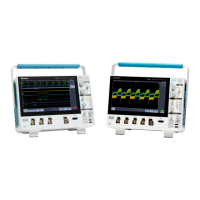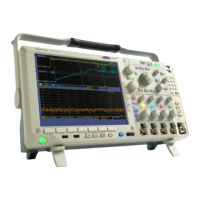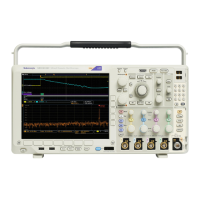Command Groups
Spectrogram sl
ices are generated by taking each spectrum and flipping it on its
edge, so that it is one pixel row tall. Each new acquisition adds another slice at the
bottom of the spectrogram, and the previous acquisitions (slices) move up one
row; you can then navigate backwards through the history of the spectrogramby
selecting slice numbers to view. (The spectrogram slice trace is displayedas
the RF Normal trace.)
Spectrum Mo
de: Triggered
and Free Run
When only the frequency domain waveforms are displayed (no time domain
waveforms), you can choose whether the MDO4000/B/C should use Triggered
mode or Free Run mode. (MDO3000 only uses Free Run mode.) When Triggered
mode is se
lected, you can control all trigger settings, including Normal and
Auto triggering. When Free Run mode is selected, the oscilloscope generates
RF acquisitions as fast as possible. (To display only the frequency domain
waveforms, turn off all time domain waveforms, including channels 1- 4, digital
channels 0 - 15, buses, time domain math waveforms, time domain reference
waveforms, and any RF vs. Time traces.)
When the oscilloscope displays both time and frequency domain waveforms,
then the instrument’s trigger system is in control of the Triggered mode andthe
RF acq
uisitions.
Using Markers in the
Frequency Domain for
Measurement and Analysis
For frequency domain measurements, up to 11 automatic markers are available
to assist with quickly identifying the frequency and amplitude of peaks in the
spe
ctrum based upon user threshold and excursion settings. If more peaks meet
the criteria than the desired number of markers, then the highest amplitudepeaks
are shown. Two manual markers are also available for measuring non-peak areas
of interest, and to measure Noise Density and Phase Noise. If manual markersare
off, the reference marker is automatically placed on the highest amplitudepeak.
With manual markers on, the reference marker becomes the “A” manual marker.
A
utomatic peak markers are on by default.
Each automatic marker has a readout associated with it. These can be absolute
o
r delta readouts. An absolute marker readout shows the actual frequency and
amplitude of the associated marker. A delta marker readout shows the frequency
and amplitude of the automatic markers relative to the Reference Marker.
The Reference Marker’s readout indicates absolute frequency and amplitude,
regardless of the readout type. (It is marked on the display with a red R in a
triangle.) The marker measurement readouts are absolute in dBm or relativetothe
reference marker in dBc (dB below carrier amplitude).
The threshold and excursion settings define which peaks are marked automatically.
The threshold is a minimum amplitude that a signal must cross to be a valid peak.
If the threshold is lower, more peaks will tend to qualify for markers. If the
threshold is higher, fewer peaks tend to qualify for markers. The excursion is how
far a signal needs to fall in amplitude between marked peaks to be another valid
peak. If the excursion is low, more peaks will tend to qualify for markers. Ifthe
excursion is high, fewer peaks will tend to qualify for markers.
2-50 MDO4000/B/C, MSO/DPO4000B and MDO3000 Series Oscilloscopes Programmer Manual

